Finesse Fishing With Microlures
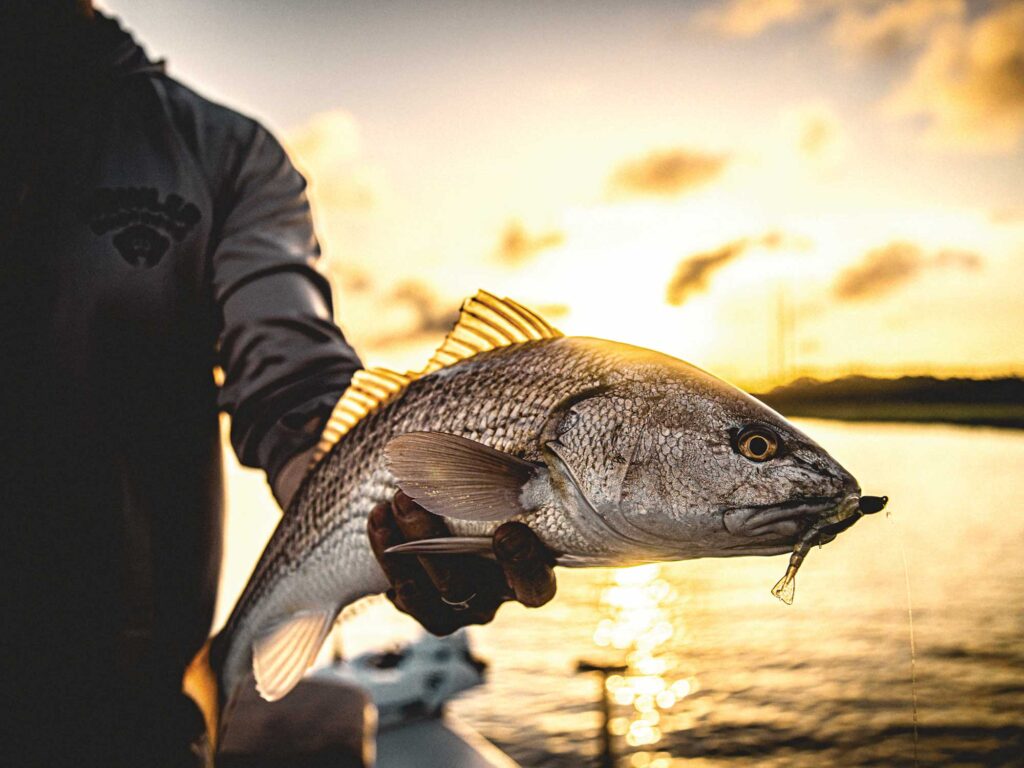 Finesse baits lead to stealthier presentations and can solve for lockjaw when there’s heavy fishing pressure.
Courtesy Z-Man
Finesse baits lead to stealthier presentations and can solve for lockjaw when there’s heavy fishing pressure.
Courtesy Z-Man
I hate to admit it, but freshwater anglers are right. After introducing saltwater anglers to buzzbaits, chatter baits and glide baits, they are now teaching us about Midwest finesse fishing. Turns out, little jigs and tiny soft plastics work just as well for striped bass and spotted bay bass as they do for largemouth and smallmouth bass. Freshwater anglers started the microlure trend, but saltwater anglers are taking finesse fishing to the next level.
Spectacular TroutCapt. Stephen Flook is a largemouth bass angler and an inshore guide out of Charleston, South Carolina, and this led him to adapt his freshwater ultralight finesse techniques to targeting spotted seatrout.
“I caught my personal best largemouth bass on a Ned rig,” Flook recalls. A Ned rig is a 2.5- to 3-inch soft plastic with a 1/10- to 1/3-ounce mushroom-head jig. The flat jig head allows the buoyant soft plastic to stand off the bottom. It didn’t take him long to realize the saltwater advantages. “Finicky trout will hit a 3-inch Ned bait before they’ll take a live shrimp,” Flook reveals.
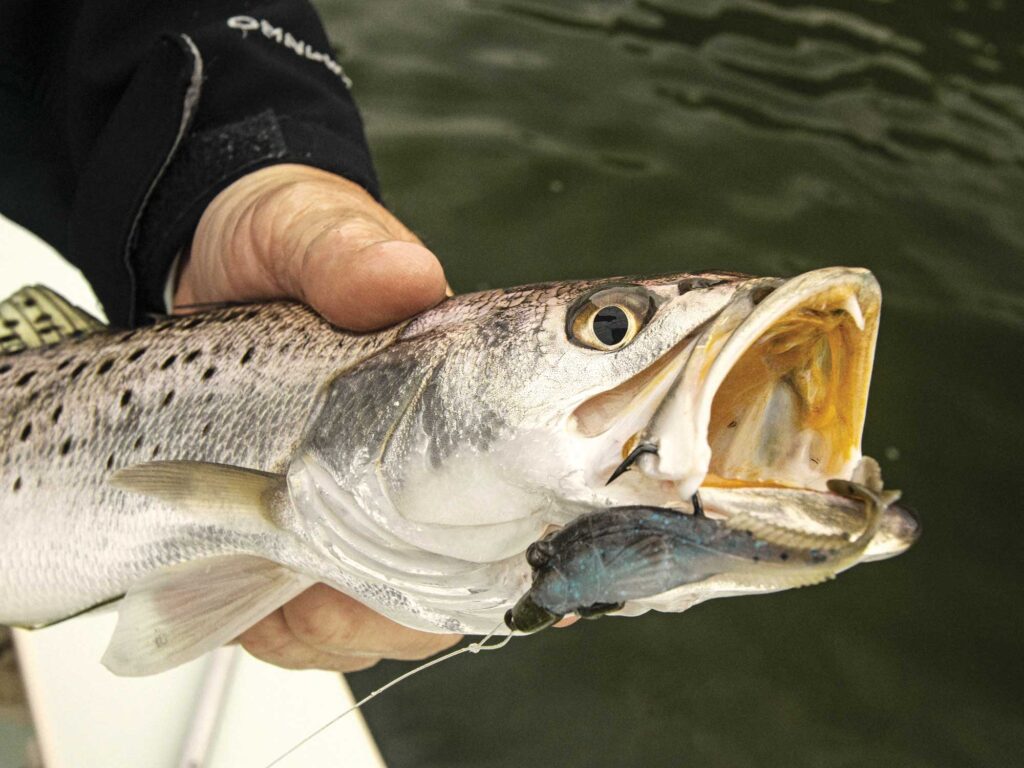 Even the biggest trout routinely eat tiny prey, so don’t be afraid to downsize.
Sam Hudson
Even the biggest trout routinely eat tiny prey, so don’t be afraid to downsize.
Sam Hudson
Flook says that other ultralight lures, such as Z-Man Salty Ned ShrimpZ, are effective under a popping cork, especially when trout are holding on structure in deep water. Docks, rocks, oyster bars and creek mouths are prime areas for fishing these, according to Flook. For fishing a popping cork, Flook starts with a 7-foot light-action spinning rod and 2000-size spinning reel spooled with 10-pound-test braided line.
To suspend the lure a few feet off the bottom, Flook ties a 4- to 8-foot length of 20-pound fluorocarbon under an oval cork and adds a Salty Ned ShrimpZ on a 1/10-ounce jig head. “After I pop the cork, the small jig sinks slowly,” Flook says. When trout are finicky, slowing their target entices the fish to bite.
Another top rig for speckled trout is a 3-inch Z-Man Slim SwimZ paddle tail on a weedless Texas Eye jig head. The Texas Eye jig head has a joint between the lead and the hook, allowing the soft plastic to dance freely in the current.
Flook casts the small lure and lets it sink to the bottom. Then he raises the rod tip to hop the jig. “The fish hit on the drop,” he says. Flook experiments with weights until he finds the fall rate that trout are keen on. “If the fish aren’t hitting a 1/6-ounce jig, I’ll switch to a 1/10-ounce jig,” Flook says.
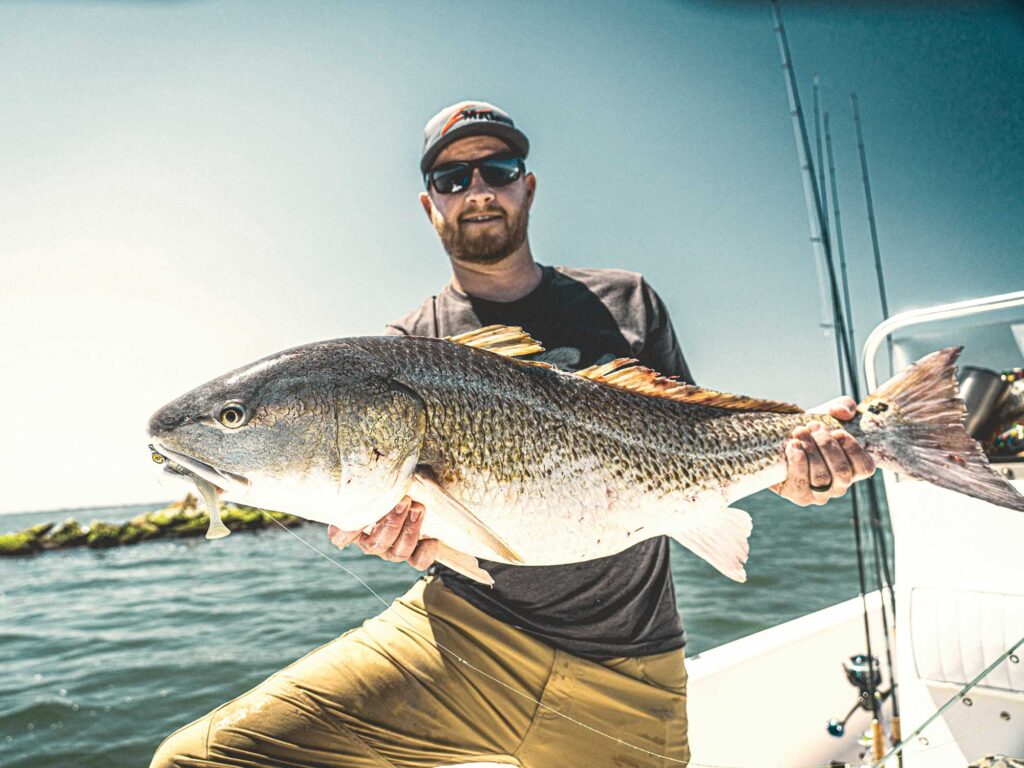 Ned rigs are particularly effective on winter redfish.
Courtesy Z-Man
Redfish Candy
Ned rigs are particularly effective on winter redfish.
Courtesy Z-Man
Redfish Candy
Even though Capt. James Dumas, a guide out of St. Augustine, Florida, rarely fishes fresh water, he knows a good thing when he sees it. “I’ve been using Ned jigs in salt for 15 years,” Dumas says.
Small and subtle, Ned rigs are particularly effective on winter redfish. “The water is shallow and clear,” Dumas says. Winter is prime time for finesse fishing, but Dumas uses the tactic on pressured redfish in summer too.
Winter redfish are feeding on small shrimp and crabs. “The 3-inch TRD CrawZ is a perfect match,” Dumas says. He fishes the small soft plastic on a mushroom-shaped Ned-style jig head.
At first, Dumas was concerned that small hooks would straighten under the pressure of a fleeing redfish. “But don’t worry,” he says, “I’ve caught 10-pound redfish on a 1/10-ounce jig.”
Dumas found another advantage to ultralight jigs: A small hook is less likely to snag on oyster shells and grass. He can throw the lure into structure with near impunity. He casts the small jig into a deep hole and lets it settle to the bottom. “It could take 10 or 15 seconds,” he says.
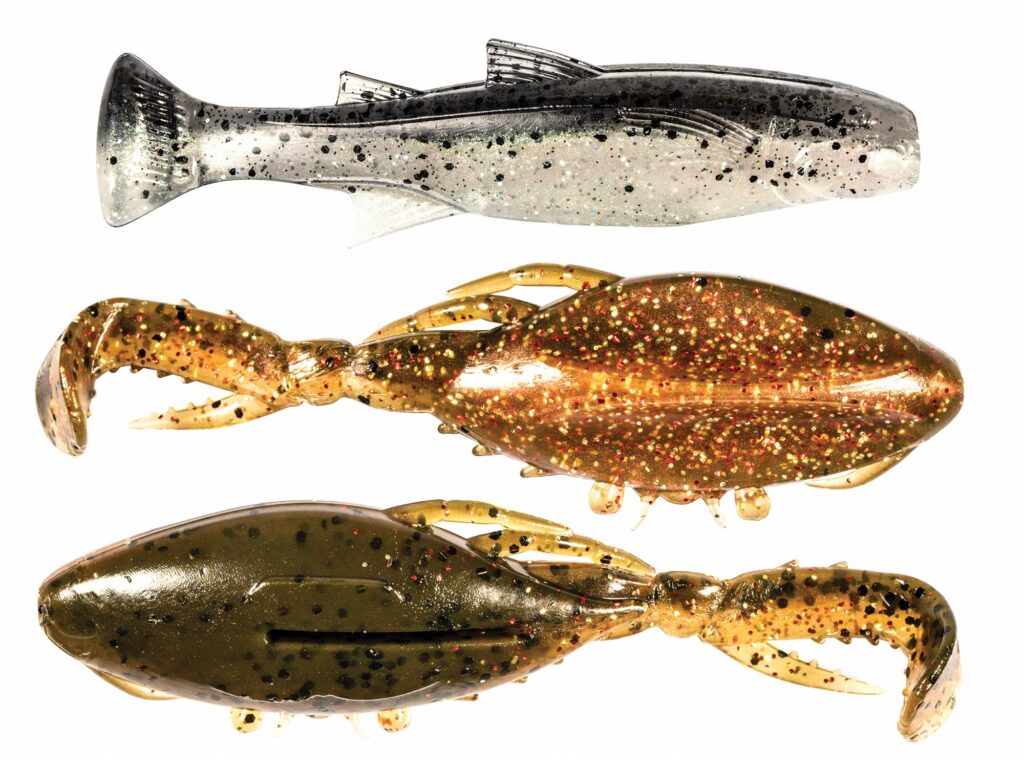 Despite their diminutive size, baits like Z-Man’s 3-inch Mulletron (top) and Kicker CrabZ (above) can tickle the fancy of even the biggest bull reds.
Courtesy Z-Man
Despite their diminutive size, baits like Z-Man’s 3-inch Mulletron (top) and Kicker CrabZ (above) can tickle the fancy of even the biggest bull reds.
Courtesy Z-Man
Dumas says the key to finesse fishing is…finesse. “If you move it too fast, the redfish won’t touch it,” he advises. Instead, he leaves the lure resting on the bottom without moving it. “It’s boring as hell, but it works,” he laughs.
When he retrieves the lure, Dumas drags it across the bottom, letting the buoyant, undulating soft plastic do the enticing.
In warm water, when the redfish are shallow, Dumas swims a small paddle tail on a 1/15-ounce jig past schooling fish. “The small lure enters the water quietly, and the jig head is so light, the lure is almost buoyant,” he says. He’s found it’s just the ticket for skittish redfish in any season.
Reef Relief“People always tell me the tackle I use is too light, but when I go heavier, I don’t catch anything,” says Elias Vaisberg. He is the host of the EliasVFishing YouTube channel, so every catch is open to criticism from across the social sphere.
Vaisberg, who fishes from a kayak much of the time, became a believer in microlures while targeting Northeast striped bass with small soft plastics and metal lures. Recently, he’s mastered tiny lures on nearshore reefs, channels and bridges from the Carolinas to the Florida Keys.
To avoid big fish breaking his light line in structure, Vaisberg positions his kayak in the transition zone between the reef and open bottom. For any chance of his light lure reaching the bottom at depths up to 40 feet, he looks for current between 0.5 and 1.5 mph. Then he drifts along the edge while bouncing the lure off the bottom. He finds the fish strike when the lure is at the apex of the hop and on the fall.
To imitate the baitfish that school around a reef, Vaisberg chooses a 2-inch curly tail or 3-inch shrimp imitation rigged on a 1/8- to 3/4-ounce Barefoot squid-shaped jig head. “The flat jig head keeps the lure horizontal as it falls,” he says.
The challenge is encouraging a light lure to sink to the bottom in waters much deeper than the typical largemouth honey hole. Vaisberg uses 20-pound-test braided line and 20-pound fluorocarbon leader. “I like eight-strand braid because it comes off the reel easier and sinks faster with increased sensitivity,” Vaisberg says. The fluorocarbon leader also helps the light lure sink faster.
Read Next: Best Soft Plastic Lures
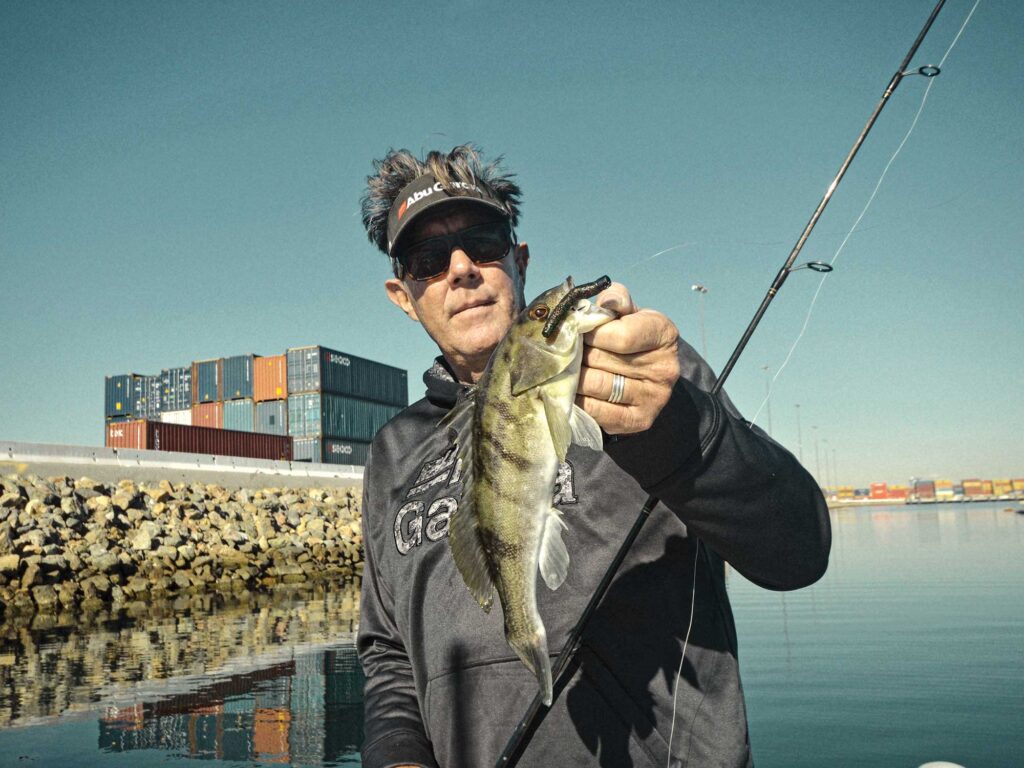 Fresh or salt, Ned rigs flat-out produce. So take a page from the BASS guys and bring the finesse gear on your next trip.
Erik Landesfeind
West Coast Bay Bass
Fresh or salt, Ned rigs flat-out produce. So take a page from the BASS guys and bring the finesse gear on your next trip.
Erik Landesfeind
West Coast Bay Bass
“A bass is a bass,” jokes Capt. Benny Florentino, a San Diego nearshore guide with Coastal Charters. “They eat the same things.” To prove his point, Florentino catches calico, sand and spotted bay bass on spinnerbaits, crankbaits, Ned rigs and drop shots.
He says the light-tackle finesse options are especially effective in winter. “When the fish are hunkered down on structure in the back of the harbor, the key is low and slow.”
Light-tackle finesse rigs are a perfect fit. Florentino primarily casts finesse lures around rock walls, grass beds and bridge pilings. “Bounce the jig down the rocks or through the structure,” he says.
Florentino goes with a classic Ned presentation, combining a 3/8-ounce mushroom jig and a 3-inch stick worm. “It looks like a little hot dog, but it works,” he jokes. Color combinations that include red or purple imitate the small critters the bay bass eat.
Stealing another classic freshwater finesse move, Florentino uses a drop-shot rig to suspend a small lure off the bottom. He starts with 36 inches of 15-pound-test fluorocarbon and ties a 1/0 drop-shot hook onto the leader 12 inches from the end.
Then he attaches a 3/8- to 1/2-ounce drop-shot sinker to the end of the line. The sliding sinker allows Florentino to adjust the depth of the soft plastic. “Sometimes the fish want the lure 8 to 12 inches off the bottom,” he says. “Sometimes they want it closer.
“When I’m fishing in tough conditions, I like to have options,” Florentino says.
Using microlures to finesse finicky fish can add a highly effective weapon to your repertoire of fish-catching techniques.
The post Finesse Fishing With Microlures appeared first on Salt Water Sportsman.
- Home
- About Us
- Write For Us / Submit Content
- Advertising And Affiliates
- Feeds And Syndication
- Contact Us
- Login
- Privacy
All Rights Reserved. Copyright , Central Coast Communications, Inc.